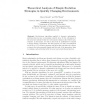Free Online Productivity Tools
i2Speak
i2Symbol
i2OCR
iTex2Img
iWeb2Print
iWeb2Shot
i2Type
iPdf2Split
iPdf2Merge
i2Bopomofo
i2Arabic
i2Style
i2Image
i2PDF
iLatex2Rtf
Sci2ools
GECCO
2003
Springer
2003
Springer
Theoretical Analysis of Simple Evolution Strategies in Quickly Changing Environments
Evolutionary algorithms applied to dynamic optimization problems has become a promising research area. So far, all papers in the area have assumed that the environment changes only between generations. In this paper, we take a first look at possibilities to handle a change during a generation. For that purpose, we derive an analytical model for a (1, 2) evolution strategy and show that sometimes it is better to ignore the environmental change until the end of the generation, than to evaluate each individual with the most up-to-date fitness function.
| Added | 06 Jul 2010 |
| Updated | 06 Jul 2010 |
| Type | Conference |
| Year | 2003 |
| Where | GECCO |
| Authors | Jürgen Branke, Wei Wang |
Comments (0)

